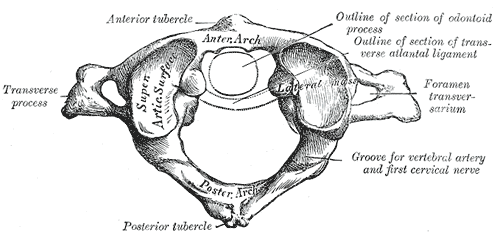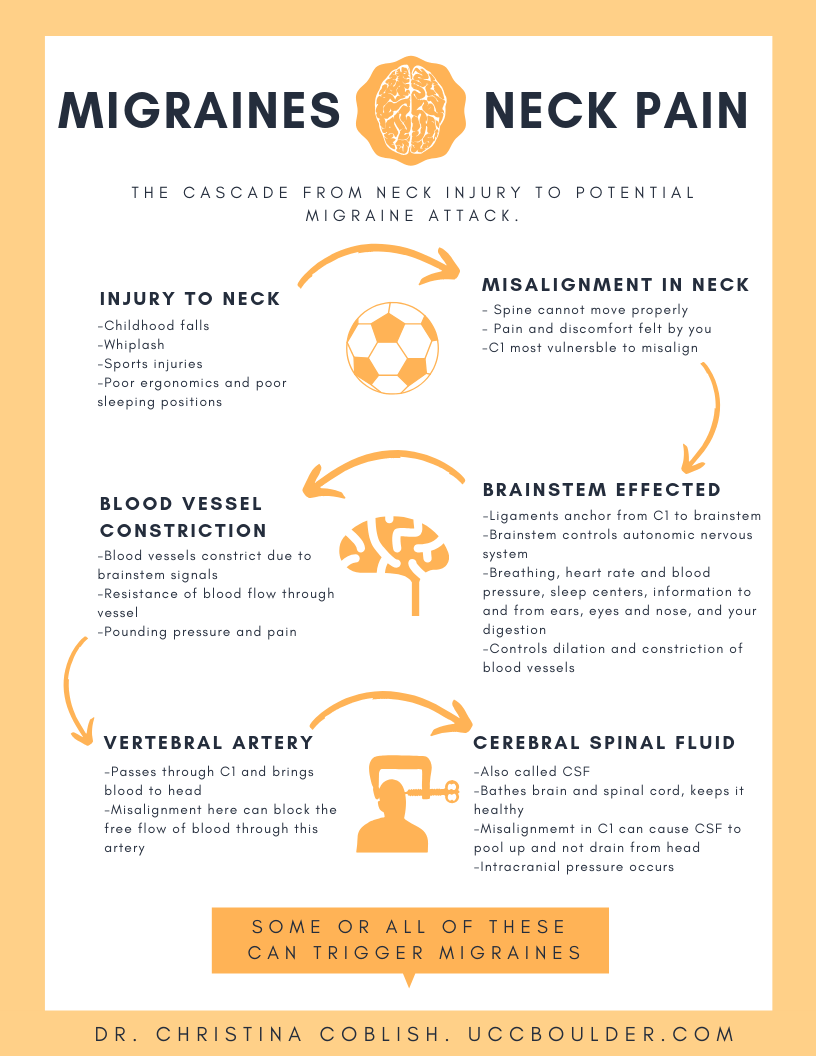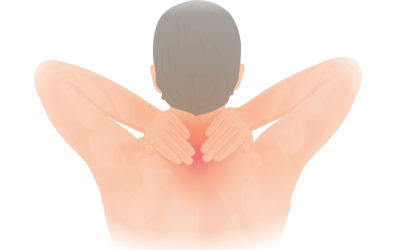In this post I’m going to break down three reasons why your migraine and neck pain are likely related to one another.
I’m a big fan of facts and research. Let’s start here.
There was this great survey done in 2018 by “Migraine In America” where they surveyed 4,356 folks suffering from migraines. In their results, they reported that 69% of the migraine participants asked reported migraine and neck pain happening at the same time.
So, what gives?
These statistics point to the relationship that your neck plays with your migraines. But, how are migraine and neck pain related to one another?

[thrive_lead_lock id=’1024′]Hidden Content[/thrive_lead_lock]
There’s a lot that of information that points to the impact that your upper cervical spine can have on your migraines. Let’s explore what could happen in your neck and your upper spine that could impact or even trigger a migraine attack.
I’d like to first make an assumption about you.
I’m going to make an assumption that at some point in your life, you sustained some kind of injury to your neck.
Maybe your injury was whiplash from a car accident.
Maybe you played sports as a child, in high school, or even a more elite level.
Maybe you fell off the bed and bumped your head at an age earlier than you can remember (some injuries take years to show up later).
Maybe you think it’s definitely possible you had an injury to the top of your neck but you can’t. quite. remember. what.
The point is, as humans, we do sustain injuries to our bodies. Sometimes they are large, more memorable injuries. These are the ones you remember to fill out on intake forms at the doctors office.
However, many times the kind of injuries that effect the bones in your neck come from smaller and less memorable injuries.
So before you decide that you’ve never sustained an injury to your neck and that the rest of this information has no relevance to you- just take a moment and reflect on the possibility of a small less memorable injury.
Or the possibility of a collection of many many many small injuries over several years, or even decades.
Injuries can lead to misalignments in your spine.
[thrive_lead_lock id=’911′]Hidden Content[/thrive_lead_lock]
Misalignments can cause the bones to be unable to move through their proper range of motion.
If you’d like to impress someone at a dinner party, we call that aberrant motion in the chiropractic and medical world.
The inability for bones in your spine to move through their proper ranges of motion often leads to pain, discomfort, muscles spasms, and so forth.
Related: Migraine Myths Heard Daily By A Chiropractor- Debunked
I’d like to introduce you to my favorite two bones in the body.

Pictures here is C1 and C2. Axis and atlas. First cervical vertebrae and second cervical vertebrae.
You might think it’s weird I have favorite bones in the spine. But I’m telling you, these two are very special bones. They do some cool stuff. For example:
- Over half of the rotation in your neck (looking from left to right) comes from your C1 rotating around your C2.
- There is no spinal disc between the base of your skull, C1 OR C2.
- C1 has it’s own shape, totally and completely unique to the rest of the spinal bones.
- The highest concentration of mechanoreceptors in the body are right at the level of the upper cervical spine.
AND. The part that’s most important for you that you care about… These two bones are the most likely culprits in your spine to negatively affect processes in the body which can lead to your next migraine and neck pain.
A misalignment in your upper cervical spine affects the entire central nervous system. Most importantly a misalignment in this area negatively affects the following three things:
- Your brainstem.
- Blood flow.
- Cerebrospinal fluid drainage (CSF).
Why don’t we break down these three things individually, shall we?
1. Your brainstem.
Some more anatomy coming your way:
The atlas (C1), has many surrounding ligaments that anchor and attach to your brainstem.
Your brainstem controls everything autonomic in your body. This includes processes such as your breathing, heart rate and blood pressure, your sleep center, information to and from ears, eyes and nose, and your digestion.
Essentially, if you don’t have to think about it: that’s your autonomic nervous system (ANS).
So if we just look at it from a basic standpoint: if you have a misalignment or an injury to your upper cervical spine, do you see how it could negatively affect your brainstems ability to do its job?
If your brainstem isn’t firing on all cylinders, can you imagine the impact this could have on the body? All those autonomic processes in the body are going to not get the strongest signal from your brainstem.
On a more physiological level, it’s important to highlight that your brainstem controls the dilation and constriction of blood vessels in the body.
This is vital to understand when considering the connection of your migraine and neck pain.
Imagine you have an injury to your upper neck bones, and that injury has decreased the quality of the brainstems information to the body. One of the things that could get negatively effected is the proper dilation of blood vessels in the neck.
Have you experienced that pounding/thumping type of headache or migraine before? This could be related to blood being pushed through blood vessles that are too constricted.
Which is a great transition for our second point.
2. Blood flow.
We already talked a little bit about blood flow passing through constricted blood vessels, which can cause thumping and pounding head pain during a migraine attack.
We have more anatomy and physiology coming your way.
The cervical spine allows the passage of your vertebral arteries which carry blood to the head. The atlas is the very last bone that this vital artery passes through before bringing proper blood flow to your head.
Man, that atlas has quite the responsibility to be in charge of!
A misalignment at this segment can restrict what should be a free flow of blood from your vertebral artery.
Again, that resistance of blood being pushed through arteries causes pain at the base of the neck, and does not allow proper blood flow to pass up into your head and face.
3. Cerebrospinal fluid drainage (CSF).
CSF has a pretty important job. It essentially bathes your brain and spinal cord, keeping them both lubricated and happy.
However, if CSF cannot drain properly from the head, this can lead to increased intracranial pressure in your head.
A misalignment at the atlas can restrict CSF drainage.
This buildup of intracranial pressure often is felt during the migraine attack.
[thrive_lead_lock id=’1024′]Hidden Content[/thrive_lead_lock]
Let’s recap the connection of your migraine and neck pain with this sweet graphic:

The connection of migraine and neck pain are related closely.
Don’t let migraine and neck pain define your life. Finding a chiropractor who can objectively and accurately measure any misalignment in these bones will make a huge impact on your migraines. An Upper Cervical Chiropractor has extra training to do exactly that. I highly recommend an Upper Cervical Chiropractor to assess any connection to your migraine and neck pain.
If you are in search for a natural way to address your migraines, Upper Cervical Chiropractic care may be right for you. I urge you to schedule a consultation with a local upper cervical practitioner in your area to learn more.
If you’re in the Boulder Colorado area and you experience migraine and neck pain, then you’ll definitely want to click this link and schedule a consultation at my office. It all starts with an honest conversation.
[thrive_lead_lock id=’911′]Hidden Content[/thrive_lead_lock]
Science Junky Research Sources
Source: Graham Headache Center, Brigham and Women’s Hospital, Harvard Medical School, Boston, MA, USA.
Title: The prevalence and burden of migraine and severe headache in the United States
Year: 2015
Link: https://www.ncbi.nlm.nih.gov/pubmed/25600719
Source: BMJ.
Title:Prevalence of Headache and Migraine in School Children
Year: 1994
Link: https://www.ncbi.nlm.nih.gov/pmc/articles/PMC2541010/
Source: American Migraine Association
Title: Migraine and Aura
Year: 2016
Link: https://americanmigrainefoundation.org/understanding-migraine/migraine-and-aura/
Source: American Headache Society
Title: Migraine in America Symptoms and Treatment (MAST) Study
Year: 2018
Link: https://www.ncbi.nlm.nih.gov/pubmed/30341895


